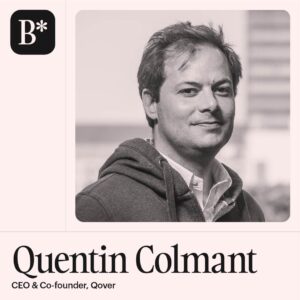Welcome to The B Word, the podcast that unravels the intricacies of B2B branding. Our monthly episodes feature guests from diverse realms, including technology, venture capital, private equity, and more. Together, we delve into the essence of branding, its mechanics, and its significance in the contemporary business landscape.
 In this episode: with guest Steve Malkin, we explore the role of certifications, emphasising the importance of trust and evidence-based data in promoting sustainable practices. The discussion highlights the challenges faced by SMEs in adopting sustainability initiatives and showcases innovative approaches, such as Planet Mark's zero-carbon bus tour, to engage businesses and communities directly. We also examine the impact of branding as an agent of change for Planet Mark's growth strategy.
In this episode: with guest Steve Malkin, we explore the role of certifications, emphasising the importance of trust and evidence-based data in promoting sustainable practices. The discussion highlights the challenges faced by SMEs in adopting sustainability initiatives and showcases innovative approaches, such as Planet Mark's zero-carbon bus tour, to engage businesses and communities directly. We also examine the impact of branding as an agent of change for Planet Mark's growth strategy.
About: Planet Mark is a sustainability certification that verifies and measures carbon and social data to reduce emissions and achieve the UN SDGs.
Episode Highlights:
What were the, what were the initial challenges you faced when you, when you launched Planet Mark?
- Initially, we thought our idea was fantastic and that everyone would love it. People love talking about sustainability, reducing carbon, and recycling, but in business, no one wanted to pay for it.
- We believed reducing carbon and cutting energy would save money, making it cost-neutral or better. Sustainability efforts offer cultural benefits, allowing people to feel passionate about improving the environment and helping organisations demonstrate their purpose and mission.
- Despite these benefits, businesses were reluctant to spend even a small amount on certification. Many businesses didn't understand the certification or couldn't fit it into their operations, causing significant challenges for us. We had to continue refining our offering and demonstrating its business value.
How do you recognise when your brand isn't fit for purpose anymore?
- The evolution of our brand has been driven by the demands of communicating in a rapidly transforming sustainability landscape and business environment.
- External challenges from peers push us to make sustainability more exciting, accessible, and empowering for everyone involved.
- To ensure it stays fit for purpose, Planet Mark strives to make its work relevant and inclusive so that people feel connected and integral to the transformative journey of certification.
Brand positioning
- The organisation came to market in 2013 when the sustainability landscape was different.
- Planet Mark wanted to differentiate from non-profits and charitable organisations in the certification space. It chose to be a for-profit organisation that gives back, particularly through partnerships like with the Eden Project.
- It needed to be positioned differently from incumbents like Carbon Trust and
pre-B Corp movements.
Brand Evolution
- The evolution of the brand has been driven by the demands of communicating in a rapidly transforming sustainability landscape and business environment.
- The approach often involves recognising plateaus and moments when the team needs to step back and assess where improvements are needed.
- External challenges from peers push Planet Mark to make sustainability more exciting, accessible, and empowering for everyone involved.
Also available on:
Listen on Apple Podcasts
Listen on Spotify
Listen on Google Podcasts
Listen on Amazon Music
 In this episode: with guest
In this episode: with guest  In this episode: we delve into the world of fractional real estate investment, demystifying complexities and exploring innovative approaches with
In this episode: we delve into the world of fractional real estate investment, demystifying complexities and exploring innovative approaches with 


